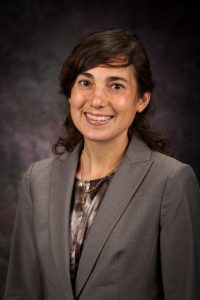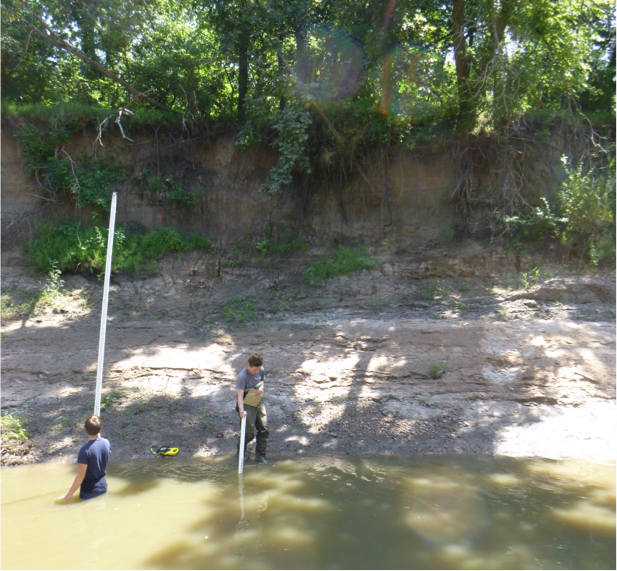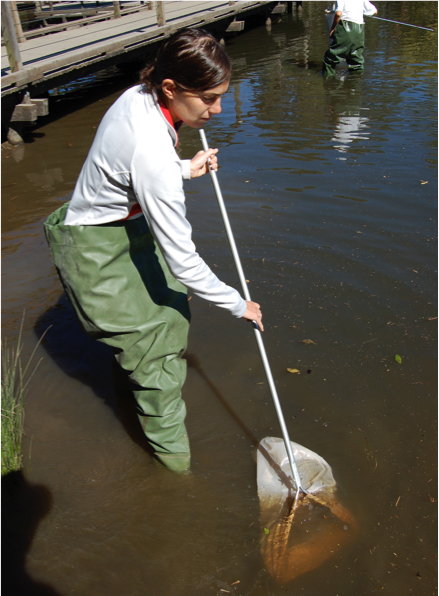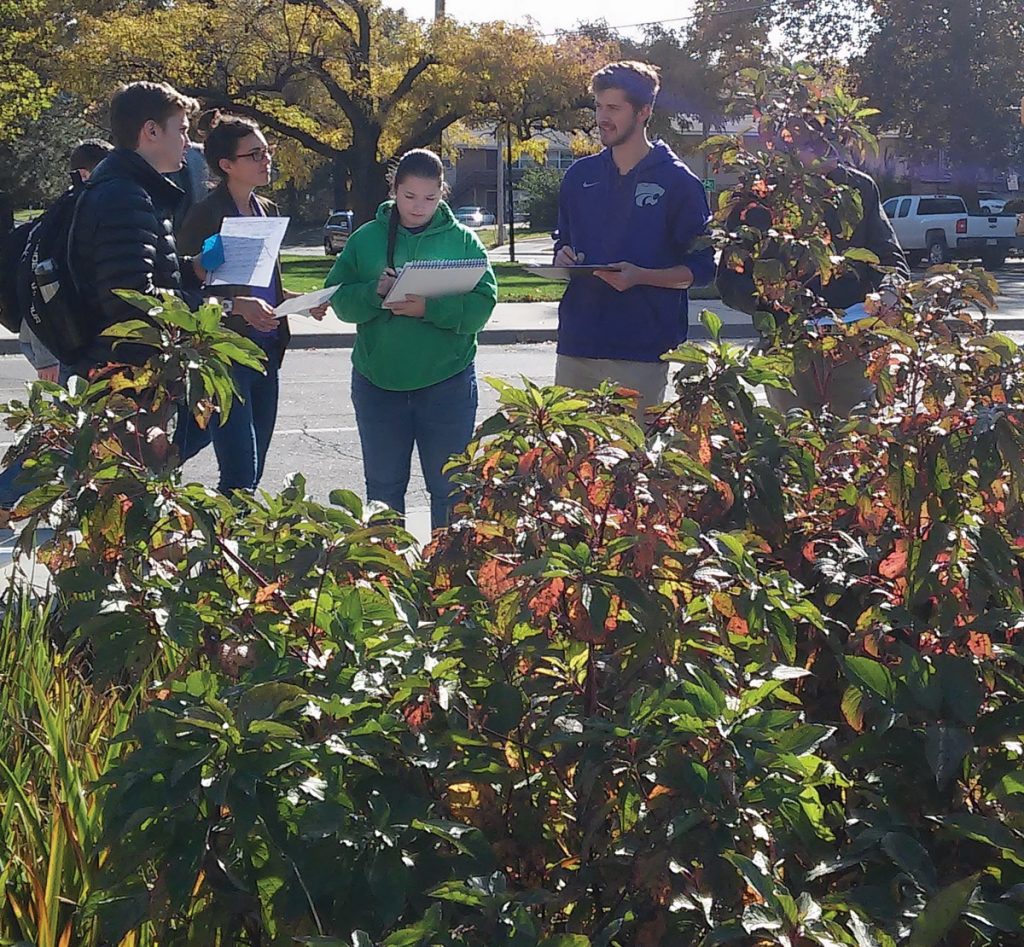How can urban trees reduce flooding and pollution?
Dr Trisha Moore is a biological and agricultural engineer based at Kansas State University in the US. Her research is wide and varied, covering both urban and rural environments. Her most recent research is focused on understanding how urban tree systems can mitigate the negative impacts of stormwater runoff
A 2015 study involving 421,529 measurements from 50 countries on six continents found that there are more than three trillion trees on our planet – roughly 400 trees for every human. That’s a lot of trees and thank goodness – they do the world a tremendous amount of good: they absorb carbon dioxide which helps slow the rate of global warming; they reduce wind speeds; they can cool the air; and they are beautiful to look at and walk amongst.
And now a team of researchers is investigating whether trees might also be able to mitigate the negative impacts of stormwater runoff in urban areas. Dr Trisha Moore, based within the Department of Biological and Agricultural Engineering at Kansas State University in the US, is the Principal Investigator of a Water Research Foundation project that is trying to document the contribution of urban tree systems to stormwater nutrient and volume control.
WHAT ARE THE MAIN PROBLEMS CAUSED BY STORMWATER RUNOFF IN URBAN AREAS?
Stormwater, as the name suggests, is that which is produced through heavy rainfall during a storm. One of the main problems is flooding, which occurs when the grates at the side of the streets and the pipes underneath the roads cannot handle the amount of rainfall. This flooding tends to bend to the will of gravity, so people living downhill often bear the brunt of the damage that stormwater causes.
Then there is the problem with the quality of the stormwater runoff. “As stormwater runs across our rooftops, lawns, streets and other surfaces in the urban landscape, it picks up all sorts of pollutants and carries them with it,” explains Trisha. “So, for example, you can have sediments washed from streets muddying up streams and smothering aquatic habitats, and a cocktail of heavy metals, salts, pesticides and other chemicals that cause harm to aquatic food webs.”
HOW CAN TREES AND NATURAL VEGETATION HELP COUNTER THESE PROBLEMS?
It is known that trees and natural vegetation generally provide a buffer to some of the negative impacts associated with stormwater runoff. However, Trisha’s project wants to quantify the magnitude of this buffering effect. To achieve this, the team conducted a meta-analysis, where the researchers look through all the studies that have been conducted in a particular area to examine the insights they provide as a whole. “A meta-analysis begins with a thorough literature review – through this, we identified all the studies to date in which the ability for urban trees to capture rainfall has been measured,” says Trisha. “Then we extracted the raw data from each of these studies and ran various statistical analyses on this entire dataset.” Ultimately, this method provides a better picture of what the studies are saying as opposed to the results from one or two studies.
WHAT METHODS DID THE TEAM USE IN THEIR INVESTIGATIONS?
Trisha and her team used a hydrological model known as i-Tree Hydro. Hydrological models estimate the volume of runoff and quantity of pollutants that would result for a given storm event in a given location. “There are many different models available, but we selected i-Tree Hydro because it explicitly represented the effects of urban tree canopy in urban areas,” explains Trisha. “It is also a tool that is readily available to stormwater managers and municipal foresters, who were the target audience for our project.”
HOW IMPORTANT HAS COLLABORATION BEEN TO THE PROJECT?
Extremely important. Trisha is keen to emphasise the different skills that everyone brought to the project and enabled the investigations to be successful. “In this project, I partnered with a forester as well as people working in more of a policy role with local governmental organisations,” says Trisha. “My role in this collaboration was to provide knowledge of urban hydrologic science and engineering to the project, the forester brought an extensive knowledge of trees, the policy collaborators brought practical knowledge and experience from working with cities, developers and decision makers on ‘green’ stormwater management initiatives.”
HOW EFFECTIVE ARE URBAN TREE CANOPIES IN DEALING WITH STORMWATER-RELATED ISSUES?
Trisha’s analysis showed that urban tree canopies can capture almost 50% of rainfall for storms up to 25mm when the trees have leaves, and up to 20-30% for storms with more than 50mm.
However, as with many questions involving ecological systems, so much depends on the specific circumstances. “While deciduous trees capture a similar amount of rainfall as evergreen during leaf-on periods, if you live in a place that gets the majority of its precipitation during the winter months, then evergreen trees are going to provide a greater stormwater benefit,” explains Trisha. “If you live in a place where summer thunderstorms cause localised urban flooding, then evergreen or deciduous trees may have an impact to slow and decrease runoff and associated flooding.”
Although there are complexities, Trisha and her team are hopeful that the outcomes from their meta-analysis and the i-Tree Hydro modelling will provide stormwater managers with new tools and insights that justify including urban tree canopy expansion and preservation in their stormwater management plans.
 DR TRISHA MOORE
DR TRISHA MOOREAssociate Professor, Department of Biological and Agricultural Engineering, Kansas State University, USA
FIELD OF RESEARCH: Biological and Agricultural Engineering
RESEARCH PROJECT: Trisha’s research focuses on the application of ecological principals to engineering design and management to improve the quality of our aquatic ecosystems.
Her most recent project uses meta-analysis and hydrological models to quantify the extent to which trees might be able to mitigate the negative impacts of stormwater runoff in urban areas. The findings could prevent flooding and pollution.
FUNDER: State of Kansas, Kansas Water Resources
Institute, Water Research Foundation,
U.S. Department of Agriculture
ABOUT BIOLOGICAL AND AGRICULTURAL ENGINEERING
One of the things that Trisha loves about the field of biological and agricultural engineering is that it encompasses diverse areas of research and technological applications. Through close collaboration, scientists with different skills and expertise are able to develop engineering solutions to a wide range of problems that have the potential to benefit people and nature.
Though Trisha has clearly spent much time studying the importance of the urban tree canopy, this is by no means the sum of her work. Trisha, and biological and agricultural engineers like her, work to understand the processes by which natural-based engineered systems contribute to the production of ecosystem services. One project could see her looking at water quality, while another could see her analysing stream erosion, while another will involve her studying climate regulation. Carrying out research in both urban and rural settings means Trisha is rarely without a fascinating project to get her engineering teeth into!
WHAT DOES TRISHA FIND MOST REWARDING ABOUT HER WORK?
Trisha’s work is driven by a desire to make the interface between people and biological systems more sustainable – something that is especially important given climate change and global warming. “I design and study systems that are modelled after natural ecosystems and designed to protect aquatic systems from pollution, flooding or other disservices caused by human activities,” explains Trisha. “Having a role in protecting our natural resources is very rewarding.” She also believes that what is good for the resource is good for all of us – cleaner water in our streams and lakes is better for anyone who fishes, swims, watches wildlife, drinks or irrigates from aquatic resources.
HOW DOES TRISHA APPROACH PROJECTS WITH SIGNIFICANT COMPLEXITIES?
Ecological systems are complex. We humans are part of those systems, and any time we make a change to that system, it is likely to change in ways we do not expect. Another area in which Trisha works – streambank management and restoration – provides a prime example of this. In some cases, efforts to prevent streambank erosion actually have the potential to accelerate it. Clearly, streams are complex systems and there are a lot of factors to consider when attempting to develop engineering solutions. “Stream restoration and stabilisation is as much art as it is science – and that is part of what makes working in these systems fun! To try to better understand the science so that we can design and install these systems with better, more predictable outcomes,” says Trisha. “A few of the factors to consider include the type of stream and if it is actively degrading (that is, eroding more than it builds up sand bars or other features) or if it is more of a dynamic equilibrium (that is, eroding but also depositing material at a similar rate so that the overall dimension of the stream is not changing).”
In Kansas, where Trisha works, the majority of streams are privately owned, so to make any project successful the team might have to work with 10 different landowners on either side of the stream. Therefore, any design that the team comes up with must be feasible from the point of view of several landowners.
Reference
https://doi.org/10.33424/FUTURUM83
A 2015 study involving 421,529 measurements from 50 countries on six continents found that there are more than three trillion trees on our planet – roughly 400 trees for every human. That’s a lot of trees and thank goodness – they do the world a tremendous amount of good: they absorb carbon dioxide which helps slow the rate of global warming; they reduce wind speeds; they can cool the air; and they are beautiful to look at and walk amongst.
And now a team of researchers is investigating whether trees might also be able to mitigate the negative impacts of stormwater runoff in urban areas. Dr Trisha Moore, based within the Department of Biological and Agricultural Engineering at Kansas State University in the US, is the Principal Investigator of a Water Research Foundation project that is trying to document the contribution of urban tree systems to stormwater nutrient and volume control.
WHAT ARE THE MAIN PROBLEMS CAUSED BY STORMWATER RUNOFF IN URBAN AREAS?
Stormwater, as the name suggests, is that which is produced through heavy rainfall during a storm. One of the main problems is flooding, which occurs when the grates at the side of the streets and the pipes underneath the roads cannot handle the amount of rainfall. This flooding tends to bend to the will of gravity, so people living downhill often bear the brunt of the damage that stormwater causes.
Then there is the problem with the quality of the stormwater runoff. “As stormwater runs across our rooftops, lawns, streets and other surfaces in the urban landscape, it picks up all sorts of pollutants and carries them with it,” explains Trisha. “So, for example, you can have sediments washed from streets muddying up streams and smothering aquatic habitats, and a cocktail of heavy metals, salts, pesticides and other chemicals that cause harm to aquatic food webs.”
HOW CAN TREES AND NATURAL VEGETATION HELP COUNTER THESE PROBLEMS?
It is known that trees and natural vegetation generally provide a buffer to some of the negative impacts associated with stormwater runoff. However, Trisha’s project wants to quantify the magnitude of this buffering effect. To achieve this, the team conducted a meta-analysis, where the researchers look through all the studies that have been conducted in a particular area to examine the insights they provide as a whole. “A meta-analysis begins with a thorough literature review – through this, we identified all the studies to date in which the ability for urban trees to capture rainfall has been measured,” says Trisha. “Then we extracted the raw data from each of these studies and ran various statistical analyses on this entire dataset.” Ultimately, this method provides a better picture of what the studies are saying as opposed to the results from one or two studies.
WHAT METHODS DID THE TEAM USE IN THEIR INVESTIGATIONS?
Trisha and her team used a hydrological model known as i-Tree Hydro. Hydrological models estimate the volume of runoff and quantity of pollutants that would result for a given storm event in a given location. “There are many different models available, but we selected i-Tree Hydro because it explicitly represented the effects of urban tree canopy in urban areas,” explains Trisha. “It is also a tool that is readily available to stormwater managers and municipal foresters, who were the target audience for our project.”
HOW IMPORTANT HAS COLLABORATION BEEN TO THE PROJECT?
Extremely important. Trisha is keen to emphasise the different skills that everyone brought to the project and enabled the investigations to be successful. “In this project, I partnered with a forester as well as people working in more of a policy role with local governmental organisations,” says Trisha. “My role in this collaboration was to provide knowledge of urban hydrologic science and engineering to the project, the forester brought an extensive knowledge of trees, the policy collaborators brought practical knowledge and experience from working with cities, developers and decision makers on ‘green’ stormwater management initiatives.”
HOW EFFECTIVE ARE URBAN TREE CANOPIES IN DEALING WITH STORMWATER-RELATED ISSUES?
Trisha’s analysis showed that urban tree canopies can capture almost 50% of rainfall for storms up to 25mm when the trees have leaves, and up to 20-30% for storms with more than 50mm.
However, as with many questions involving ecological systems, so much depends on the specific circumstances. “While deciduous trees capture a similar amount of rainfall as evergreen during leaf-on periods, if you live in a place that gets the majority of its precipitation during the winter months, then evergreen trees are going to provide a greater stormwater benefit,” explains Trisha. “If you live in a place where summer thunderstorms cause localised urban flooding, then evergreen or deciduous trees may have an impact to slow and decrease runoff and associated flooding.”
Although there are complexities, Trisha and her team are hopeful that the outcomes from their meta-analysis and the i-Tree Hydro modelling will provide stormwater managers with new tools and insights that justify including urban tree canopy expansion and preservation in their stormwater management plans.
In Kansas, where Trisha works, the majority of streams are privately owned, so to make any project successful the team might have to work with 10 different landowners on either side of the stream. Therefore, any design that the team comes up with must be feasible from the point of view of several landowners.
 DR TRISHA MOORE
DR TRISHA MOORE
Associate Professor, Department of Biological and Agricultural Engineering, Kansas State University, USA
FIELD OF RESEARCH: Biological and Agricultural Engineering
RESEARCH PROJECT: Trisha’s research focuses on the application of ecological principals to engineering design and management to improve the quality of our aquatic ecosystems.
Her most recent project uses meta-analysis and hydrological models to quantify the extent to which trees might be able to mitigate the negative impacts of stormwater runoff in urban areas. The findings could prevent flooding and pollution.
FUNDER: State of Kansas, Kansas Water Resources
Institute, Water Research Foundation,
U.S. Department of Agriculture
ABOUT BIOLOGICAL AND AGRICULTURAL ENGINEERING
One of the things that Trisha loves about the field of biological and agricultural engineering is that it encompasses diverse areas of research and technological applications. Through close collaboration, scientists with different skills and expertise are able to develop engineering solutions to a wide range of problems that have the potential to benefit people and nature.
Though Trisha has clearly spent much time studying the importance of the urban tree canopy, this is by no means the sum of her work. Trisha, and biological and agricultural engineers like her, work to understand the processes by which natural-based engineered systems contribute to the production of ecosystem services. One project could see her looking at water quality, while another could see her analysing stream erosion, while another will involve her studying climate regulation. Carrying out research in both urban and rural settings means Trisha is rarely without a fascinating project to get her engineering teeth into!
WHAT DOES TRISHA FIND MOST REWARDING ABOUT HER WORK?
Trisha’s work is driven by a desire to make the interface between people and biological systems more sustainable – something that is especially important given climate change and global warming. “I design and study systems that are modelled after natural ecosystems and designed to protect aquatic systems from pollution, flooding or other disservices caused by human activities,” explains Trisha. “Having a role in protecting our natural resources is very rewarding.” She also believes that what is good for the resource is good for all of us – cleaner water in our streams and lakes is better for anyone who fishes, swims, watches wildlife, drinks or irrigates from aquatic resources.
HOW DOES TRISHA APPROACH PROJECTS WITH SIGNIFICANT COMPLEXITIES?
Ecological systems are complex. We humans are part of those systems, and any time we make a change to that system, it is likely to change in ways we do not expect. Another area in which Trisha works – streambank management and restoration – provides a prime example of this. In some cases, efforts to prevent streambank erosion actually have the potential to accelerate it. Clearly, streams are complex systems and there are a lot of factors to consider when attempting to develop engineering solutions. “Stream restoration and stabilisation is as much art as it is science – and that is part of what makes working in these systems fun! To try to better understand the science so that we can design and install these systems with better, more predictable outcomes,” says Trisha. “A few of the factors to consider include the type of stream and if it is actively degrading (that is, eroding more than it builds up sand bars or other features) or if it is more of a dynamic equilibrium (that is, eroding but also depositing material at a similar rate so that the overall dimension of the stream is not changing).”
WHAT ARE THE BIG ISSUES FACING TODAY’S BIOLOGICAL AND AGRICULTURAL ENGINEERS?
A huge challenge facing scientists around the world is ensuring the ever-increasing global population has access to food, clean water, and other ecosystem services, at the same time as ensuring that we sustain the planet’s ability to provide these services. Biological and agricultural engineers are no different. As Trisha points out, “These issues directly impact all of us and transcend any one discipline or group of experts. This is another reason that biological and agricultural engineers (and, in my opinion, anyone working on these problems) should also strive to work collaboratively with people in other disciplines.”
HOW TO BECOME AN AGRICULTURAL AND BIOLOGICAL ENGINEER
• The American Society of Agricultural and Biological Engineers is a vast resource for those interested in sharing ideas and advancing their careers: https://www.asabe.org
• The International Commission of Agricultural and Biosystems Engineering is a global organisation that brings together the agricultural engineering community: http://cigr.org/
• Agricultural engineers can expect an average salary of around $71,730, depending on experience and where in the US you are based. Engineering jobs pay typical salaries of around $91,000, while academia and research positions pay around $51,000.
PATHWAY FROM SCHOOL TO BIOLOGICAL AND AGRICULTURAL ENGINEERING
“Math and science are really important to any engineering discipline. For biological and agricultural engineering, it helps to have a background in natural and earth sciences (e.g. biology, environmental science, geology) as well as physics and chemistry,” says Trisha. “So, any courses you can take that expose you to these areas will be helpful. Gaining some background in sociology or other human-centric courses can also be valuable.”
2 or 3 A levels, or equivalent.
Entry-level jobs in agricultural engineering require a bachelor’s degree, preferably in agricultural or biological engineering. Agricultural engineers who offer their services directly to the public must be licenced as professional engineers.
https://www.environmentalscience.org/career/agricultural-engineer
HOW DID DR TRISHA MOORE BECOME AN ENGINEER?
WHAT INTERESTS DID YOU HAVE AS A CHILD?
I really enjoyed the outdoors and was interested in anything I could find or do there – turtles and snakes, strange-looking insects, wading in streams, hiking trails and camping with my family. One of my fondest memories is trying to catch bullfrogs (and sometimes succeeding) in the ponds near my house on warm summer evenings. I also really enjoyed reading. My dad is a wildlife biologist and my mom was a librarian, so it is no surprise that I was drawn to these things.
WHY DID YOU TAKE THE CAREER PATH YOU DID?
Maths and science were among my favourite subject areas in school. I considered studying the biological sciences, and specifically herpetology – I was really fascinated by reptiles and amphibians growing up, but a couple of things swayed me toward engineering. First, during my senior year of high school, my physics teacher encouraged me to apply for a local scholarship that helped support students from my town majoring in engineering. Second, I have an aunt who is a civil engineer and encouraged me to consider engineering because (and I am paraphrasing here) the world needs engineers who understand both the physical aspects of design but also the environmental and ecological systems which they work within. She opened my eyes to environmental engineering and the role that engineers can play to protect and/or restore the environmental systems (e.g. streams and rivers) and resident fauna (e.g. turtles and frogs) in which I was so interested. I think I was the only applicant for the local scholarship, so I was on the hook to pursue engineering at my university after I accepted it!
HOW DO YOU MOTIVATE YOURSELF WHEN YOU FACE AN OBSTACLE?
I find that many of the obstacles I encounter are because of the way I am thinking about the problem. For me, the best way to give myself space to think about it differently is to take a break and go for a run. I find I am better able to examine the problem from a different perspective, iron out alternative strategies and think about the people who could help me tackle the issue.
WHAT NON WORK-RELATED ACTIVITY IS ON THE TOP OF YOUR ‘BUCKET LIST’?
I have enjoyed running since I was a young girl and have even ran marathons. One of my bucket list activities is to complete an ultramarathon at some point in the future!
TRISHA’S TOP TIPS
1 Be persistent! Engineering coursework is notoriously challenging, but I think it is well worth the effort to set you on a path to contribute to solutions to many of the environmental challenges facing our planet.
2 Be open to listening to and working with people from other academic disciplines and backgrounds. The global challenges we face transcend any single area of expertise, so I believe you can make an even bigger impact if you are able to work collaboratively with people from diverse backgrounds.
3 We tend to emphasise technical coursework for an engineering career, but strong communication skills – especially written – are extremely important for engineers. So, pay attention in your English courses and take technical writing classes if you get the opportunity.













